The COVID-19 Pandemic and the Digital Transformation of Workplace: The Social Representation of Home-Office
Abstract
1. Introduction
2. Theoretical Background
2.1. Teleworking
2.2. Home-Based Teleworking or Home-Office
2.3. Social Representation Theory
2.4. Central Nucleus Theory
3. Methodological Procedures
4. Results
4.1. Sample
4.2. Vergès’ Quadrant
4.3. Implicative Analysis
5. Discussion
Home-Office: Theory vs. Social Representation
6. Conclusions
6.1. Research Implications
6.2. Research Limitations
Author Contributions
Funding
Institutional Review Board Statement
Informed Consent Statement
Data Availability Statement
Conflicts of Interest
References
- Home Office. 2020. Available online: https://carreira.com.br/conteudos/estudos/home-office/ (accessed on 31 August 2020).
- Results of Pulse Survey Impact of COVID-19 on Rewards & Benefits. Available online: https://www.kornferry.com/insights/redirected-content/rewards-and-benefits-pulse-survey-1-report (accessed on 6 September 2020).
- Impactos e Respostas aos Efeitos do COVID-19. Available online: https://home.kpmg/br/pt/home/insights.html (accessed on 23 August 2020).
- The Next Normal. The Recovery Will Be Digital: Digitizing at Speed and Scale. Available online: https://www.mckinsey.com/~/media/McKinsey/Business%20Functions/McKinsey%20Digital/Our%20Insights/How%20six%20companies%20are%20using%20technology%20and%20data%20to%20transform%20themselves/The-next-normal-the-recovery-will-be-digital-vF.pdf (accessed on 31 August 2020).
- Nogueira, A.M.; Patini, A.C. Trabalho remoto e desafios dos gestores. RAI Rev. Adm. Inovação 2012, 9, 121–152. [Google Scholar]
- Muzzio, H. A condição paradoxal da administração de recursos humanos: Entre a racionalidade instrumental e a racionalidade substantiva. Cad. Ebape BR 2014, 12, 706–718. [Google Scholar] [CrossRef][Green Version]
- Fernandes, B.H.R. Gestão de negócios e pessoas na Indústria 4.0. DOM 2018, 11, 86–91. [Google Scholar]
- Collings, D.G.; Nyberg, A.J.; Wright, P.M.; McMackin, J. Leading through paradox in a COVID-19 world: Human resources comes of age. Hum. Resour. Manag. J. 2021, 31, 819–833. [Google Scholar] [CrossRef]
- Moscovici, S. La Psychanalyse, Son Image et Son Public; Presses Universitaires de France: Paris, France, 2015. [Google Scholar]
- Joia, L.A. A teoria da representação social e a definição de constructos na área de administração da informação. In Proceedings of the VI Encontro de Administração da Informação–EnADI, Curitiba, Brazil, 28–30 May 2017. [Google Scholar]
- Ziemba, E. The contribution of ICT adoption to the sustainable information society. J. Comput. Inf. Syst. 2019, 59, 116–126. [Google Scholar] [CrossRef]
- Fazili, A.I.; Khan, O.F. A study on the impact of ICT on work life balance. Life Sci. J. 2017, 14, 1–4. [Google Scholar]
- Boell, S.K.; Campbell, J.A.; Ćećez-Kecmanović, D.; Cheng, J.E. Advantages, challenges and contradictions of the transformative nature of telework: A review of the literature. In Proceedings of the 19th Americas Conference on Information Systems, Chicago, IL, USA, 15–17 August 2013. [Google Scholar]
- Bjursell, C.; Bergmo-Prvulovic, I.; Hedegaard, J. Telework and lifelong learning. Front. Sociol. 2021, 6, 642277. [Google Scholar] [CrossRef] [PubMed]
- López-Igual, P.; Rodríguez-Modroño, P. Who is teleworking and where from? Exploring the main determinants of telework in Europe. Sustainability 2020, 12, 8797. [Google Scholar] [CrossRef]
- Coelho, F.A.; Faiad, C.; Rego, M.C.B.; Ramos, W.M. What Brazilian workers think about flexible work and telework? Int. J. Bus. Excell. 2020, 20, 16–31. [Google Scholar]
- Nilles, J.M.; Carlson, F.R.; Gray, P.; Hanneman, G. Telecommuting-an alternative to urban transportation congestion. IEEE Trans. Syst. Man. Cybern. 1976, 2, 77–84. [Google Scholar] [CrossRef]
- Pyöriä, P. Managing telework: Risks, fears and rules. Manag. Res. Rev. 2011, 34, 386–399. [Google Scholar] [CrossRef]
- Messenger, J.C.; Gschwind, L. Three generations of Telework: New ICT s and the (R) evolution from Home Office to Virtual Office. New Technol. Work Employ. 2016, 31, 195–208. [Google Scholar] [CrossRef]
- Pinto, A.R.; Coelho, D.M.; Pereira, R. Teleworking: New Challenges and Trends. In Handbook of Research on Solving Societal Challenges through Sustainability-Oriented Innovation; IGI Global: Hershey, PA, USA, 2023; pp. 183–200. [Google Scholar]
- Boell, S.K.; Cecez-Kecmanovic, D.; Campbell, J. Telework paradoxes and practices: The importance of the nature of work. New Technol. Work Employ. 2016, 31, 114–131. [Google Scholar] [CrossRef]
- Bailey, N.B.K.D.E.; Kurland, N.B. The advantages and challenges of working here, there, anywhere, and anytime. Organ. Dyn. 1999, 28, 53–68. [Google Scholar]
- Standen, P.; Daniels, K.; Lamond, D. The home as a workplace: Work–family interaction and psychological well-being in telework. J. Occup. Health Psychol. 1999, 4, 368. [Google Scholar] [CrossRef] [PubMed]
- Madsen, S.R. The Benefits, Challenges, and Implications of Teleworking: A Literature Review. Cult. Relig. Rev. J. 2011, 2011, 1. [Google Scholar]
- Overmyer, S.P. Implementing Telework: Lessons Learned from Four Federal Agencies; IBM Center for the Business of Government: Arlington, VA, USA, 2011; pp. 8–15. [Google Scholar]
- Mahler, J. The telework divide: Managerial and personnel challenges of telework. Rev. Public Pers. Adm. 2012, 32, 407–418. [Google Scholar] [CrossRef]
- Donnelly, N.; Proctor-Thomson, S.B. Disrupted work: Home-based teleworking (HbTW) in the aftermath of a natural disaster. New Technol. Work Employ. 2015, 30, 47–61. [Google Scholar] [CrossRef]
- Groen, B.A.; Van Triest, S.P.; Coers, M.; Wtenweerde, N. Managing flexible work arrangements: Teleworking and output controls. Eur. Manag. J. 2018, 36, 727–735. [Google Scholar] [CrossRef]
- Joia, L.A.; Michelotto, F. Universalists or utilitarianists? The social representation of COVID-19 pandemic in Brazil. Sustainability 2020, 12, 10434. [Google Scholar] [CrossRef]
- Joia, L.A.; Michelotto, F.; Lorenzo, M. Sustainability and the Social Representation of the COVID-19 Pandemic: A Missing Link. Sustainability 2022, 14, 10527. [Google Scholar] [CrossRef]
- Shibayama, T.; Sandholzer, F.; Laa, B.; Brezina, T. Impact of COVID-19 lockdown on commuting: A multi-country perspective. Eur. J. Transp. Infrastruct. Res. 2021, 21, 70–93. [Google Scholar] [CrossRef]
- Hislop, D.; Axtell, C. The neglect of spatial mobility in contemporary studies of work: The case of telework. New Technol. Work Employ. 2007, 22, 34–51. [Google Scholar] [CrossRef]
- Rodríguez-Modroño, P.; López-Igual, P. Job Quality and Work—Life Balance of Teleworkers. Int. J. Environ. Res. Public Health 2021, 18, 3239. [Google Scholar] [CrossRef] [PubMed]
- Orlikowski, W.J.; Scott, S.V. Sociomateriality: Challenging the separation of technology, work and organization. Acad. Manag. Ann. 2008, 2, 433–474. [Google Scholar] [CrossRef]
- Kim, T.; Mullins, L.B.; Yoon, T. Supervision of telework: A key to organizational performance. Am. Rev. Public Adm. 2021, 51, 263–277. [Google Scholar] [CrossRef]
- Sullivan, C. What’s in a name? Definitions and conceptualisations of teleworking and homeworking. New Technol. Work Employ. 2003, 18, 158–165. [Google Scholar] [CrossRef]
- Thulin, E.; Vilhelmson, B.; Johansson, M. New telework, time pressure, and time use control in everyday life. Sustainability 2019, 11, 3067. [Google Scholar] [CrossRef]
- Leonardo, L.F. Home Office ou Home Off? Representação Social do Trabalho Remoto durante a Pandemia de COVID-19 na Perspectiva de Profissionais de RH. Master’s Thesis, Brazilian School of Public and Business Administration at Getulio Vargas, Rio de Janeiro, Brazil, 2021. Available online: https://bibliotecadigital.fgv.br/dspace/bitstream/handle/10438/30192/14%20FACHIN%20LEONARDO%2C%20L.%20Home%20Office%20ou%20Home%20Off.%20Disserta%C3%A7%C3%A3o%20de%20Mestrado.%202021.pdf?sequenc2007e=3&isAllowed=y (accessed on 31 August 2023).
- Eurofound. Telework in the European Union. European Foundation for the Improvement of Living and Working Conditions. Available online: https://www.eurofound.europa.eu/sites/default/files/ef_files/docs/eiro/tn0910050s/tn0910050s.pdf (accessed on 11 January 2022).
- ILO. Working Anytime, Anywhere: The Effects on the World Of Work. Publications Office of the European Union, Luxembourg, and the International Labour Office, Geneva. Available online: https://www.eurofound.europa.eu/sites/default/files/ef_publication/field_ef_document/ef1658en.pdf (accessed on 11 January 2022).
- Tremblay, D.G.; Thomsin, L. Telework and mobile working: Analysis of its benefits and drawbacks. Int. J. Work Innov. 2012, 1, 100–113. [Google Scholar] [CrossRef]
- Messenger, J.C. Introduction: Telework in the 21st century—An evolutionary perspective. In Telework in the 21st Century; Edward Elgar Publishing: Cheltenham, UK, 2019; pp. 1–34. [Google Scholar]
- Mallett, O.; Marks, A.; Skountridaki, L. Where does work belong anymore? The implications of intensive home-based working. Gend. Manag. Int. J. 2020, 35, 657–665. [Google Scholar] [CrossRef]
- Webster, J.; Watson, R.T. Analyzing the Past to Prepare for the Future: Writing a Literature Review. MIS Q. 2002, 26, 13–23. [Google Scholar]
- Wheatley, D. Good to be home? Time-use and satisfaction levels among home-based teleworkers. New Technol. Work Employ. 2012, 27, 224–241. [Google Scholar] [CrossRef]
- Nakrošienė, A.; Bučiūnienė, I.; Goštautaitė, B. Working from home: Characteristics and outcomes of telework. Int. J. Manpow. 2019, 40, 87–101. [Google Scholar] [CrossRef]
- Lippe, T.; Lippényi, Z. Co-workers working from home and individual and team performance. New Technol. Work Employ. 2020, 35, 60–79. [Google Scholar] [CrossRef] [PubMed]
- Tietze, S. When" work" comes" home": Coping strategies of teleworkers and their families. J. Bus. Ethics 2002, 41, 385–396. [Google Scholar] [CrossRef]
- Tietze, S. Discourse as strategic coping resource: Managing the interface between “home” and “work”. J. Organ. Change Manag. 2005, 18, 48–62. [Google Scholar] [CrossRef]
- Pérez, M.P.; Sanchez, A.M.; de Luis Carnicer, M.P. The organizational implications of human resources managers’ perception of teleworking. Pers. Rev. 2003, 32, 733–755. [Google Scholar] [CrossRef]
- Harris, L. Home-based teleworking and the employment relationship: Managerial challenges and dilemmas. Pers. Rev. 2003, 32, 422–437. [Google Scholar] [CrossRef]
- Meroño-Cerdán, A.L. Perceived benefits of and barriers to the adoption of teleworking: Peculiarities of Spanish family firms. Behav. Inf. Technol. 2017, 36, 63–74. [Google Scholar] [CrossRef]
- Malik, A.; Rosenberger, P.J.; Fitzgerald, M.; Houlcroft, L. Factors affecting smart working: Evidence from Australia. Int. J. Manpow. 2016, 37, 1042–1066. [Google Scholar] [CrossRef]
- Marková, I. ‘Giving voice’: Opening up new routes in the dialogicality of social change. J. Theory Soc. Behav. 2017, 47, 279–285. [Google Scholar] [CrossRef]
- Vergara, S.C.; Ferreira, V.C.P. Teoria das representações sociais: Uma opção para pesquisas em administração. Rev. Angrad 2007, 8, 225–241. [Google Scholar]
- Joia, L.A.; Marchisotti, G. It is so! (if you think so!)–IT professionals’ social representation of cloud computing. Internet Res. 2020, 30, 889–923. [Google Scholar] [CrossRef]
- Jodelet, D. Representações sociais: Um domínio em expansão. Represent. Sociais 2001, 17, 17–44. [Google Scholar]
- Moscovici, S. Notes towards a description of social representations. Eur. J. Soc. Psychol. 1988, 18, 211–250. [Google Scholar] [CrossRef]
- Abric, J.-C. Jeux, Conflits et Représentations Sociales. Ph.D. Thesis, Université de Provence, Aix-en-Provence, France, 1976. [Google Scholar]
- Abric, J.C. Prácticas Sociales y Representaciones; Ediciones Coyoacán: Ciudad de Mexico, Mexico, 1994. [Google Scholar]
- Sá, C.P. Núcleo Central das Representações Sociais, 2nd ed.; RJ Vozes: Petrópolis, Brazil, 2002. [Google Scholar]
- Mazzotti, A.J.A. A abordagem estrutural das representações sociais. Psicol. Educ. 2002, 14–15, 17–37. [Google Scholar]
- Valle, J.A.D.S.; Ferreira, V.C.P.; Joia, L.A. A representação social do escritório de gerenciamento de projetos na percepção de profissionais da área. Gestão Produção 2014, 21, 185–198. [Google Scholar] [CrossRef]
- Abric, J.-C. L’approche structurale des représentations sociales: Développements récents. Psychol. Soc. 2001, 2, 81–104. [Google Scholar]
- Vergès, P. EVOC—Ensemble de Programmes Permettant L’analyse des Évocations: Manuel Version 15 Octobre 2003, (Set of Programs for Analysis of Evocations: Manual Version 15 October 2003); Laboratoire Méditerranéen de Sociologie (LAMES): Aix-en-Provence, France, 2003. [Google Scholar]
- Abric, J.-C. La recherche du noyau central et de la zone muette des représentations sociales. In Méthodes d’étude des Représentations Sociales; Érès: Paris, France, 2003; p. 296. [Google Scholar]
- Jung, Y.; Pawlowski, S.D.; Wiley-Patton, S. Conducting social cognition research in IS: A methodology for eliciting and analyzing social representations. Commun. Assoc. Inf. Syst. 2009, 24, 35. [Google Scholar] [CrossRef]
- Vergara, S.C. Projetos e Relatórios de Pesquisa em Administração; Atlas: São Paulo, Brazil, 2013; Volume 14. [Google Scholar]
- Babbie, E.R. The Practice of Social Research; Cengage Learning: Boston, MA, USA, 2020. [Google Scholar]
- Pereira, C. A análise de dados nas representações sociais. Anál. Psicol. 1997, 1, 49–62. [Google Scholar]
- Flament, C. L’analyse de similitude: Une technique pour les recherches sur les représentations. Inform. Sci. Hum. 1985, 67, 1–58. [Google Scholar]
- Sá, C.P. Representações Sociais: Teoria e Pesquisa do Núcleo Central. Rev. Temas Psicol. Ribeirão Preto 1996, 4, 19–33. [Google Scholar]
- Mazzotti, A.J. Representações da identidade docente: Uma contribuição para a formulação de políticas. Ens. Avaliação Políticas Públicas Educ. 2007, 15, 579–594. [Google Scholar] [CrossRef]
- Marchand, P.; Ratinaud, P. L’analyse de similitude appliquée aux corpus textuels: Les primaires socialistes pour l’élection présidentielle française. In Actes des 11eme Journées Internationales d’Analyse Statistique des Données Textuelles, Proceedings of the 11th International Conference on the Statistical Analysis of Textual Data, Liege, Belgium, 13–15 June 2010; JADT: Paris, France, 2012; pp. 687–699. [Google Scholar]
- Pecora, A.R.; Sá, C.P.D. Memórias e representações sociais da cidade de Cuiabá, ao longo de três gerações. Psicol. Reflexão Crítica 2008, 21, 319–325. [Google Scholar] [CrossRef]
- Gras, R.; Almouloud, S.A. A implicação estatística usada como ferramenta em um exemplo de análise de dados multidimensionais. Educ. Mat. Pesqui. 2002, 4, 75–88. [Google Scholar]
- Joia, L.A.; Correia, J.C.P. CIO competencies from the IT professional perspective: Insights from Brazil. J. Glob. Inf. Manag. 2018, 26, 74–103. [Google Scholar] [CrossRef]
- Moscarola, J. Enquêtes et Analyse de Donnés avec le Sphinx; Libraire Vuibert: Paris, France, 1990. [Google Scholar]
- Wachelke, J.; Wolter, R.; Rodrigues Matos, F. Efeito do tamanho da amostra na análise de evocações para representações sociais. Liberabit 2016, 22, 153–160. [Google Scholar] [CrossRef]
- Vergara, S.C. Métodos de Pesquisa em Administração. RAC Rev. Adm. Contemp. 2005, 9, 1–2. [Google Scholar]
- Vergara, S.C.; Ferreira, V.C.P. A representação social de ONGs segundo formadores de opinião do município do Rio de Janeiro. Rev. Adm. Pública 2005, 39, 1137–1159. [Google Scholar]
- Wachelke, J.; Wolter, R. Critérios de construção e relato da análise prototípica para representações sociais. Psicol. Teor. Pesqui. 2011, 27, 521–526. [Google Scholar] [CrossRef]
- Criscuolo, C. The human side of productivity: Uncovering the role of skills and diversity for firm productivity. In OECD Productivity Working Papers, No. 29; OECD Publishing: Paris, France, 2021. [Google Scholar]
- Fayzieva, M.; Goyipnazarov, S.; Abdurakhmanova, G. Assessing the impact of teleworking on employees’ labor productivity and effectiveness of entity in the period of COVID-19. Общeствo Иннoвaции 2020, 1, 35–52. [Google Scholar] [CrossRef]
- Chang, Y.; Chien, C.; Shen, L.F. Telecommuting during the coronavirus pandemic: Future time orientation as a mediator between proactive coping and perceived work productivity in two cultural samples. Personal. Individ. Differ. 2021, 171, 110508. [Google Scholar] [CrossRef] [PubMed]
- Toscano, F.; Zappalà, S. Social isolation and stress as predictors of productivity perception and remote work satisfaction during the COVID-19 pandemic: The role of concern about the virus in a moderated double mediation. Sustainability 2020, 12, 9804. [Google Scholar] [CrossRef]
- Buomprisco, G.; Ricci, S.; Perri, R.; De Sio, S. Health and Telework: New Challenges after COVID-19 Pandemic. Eur. J. Environ. Public Health 2021, 5, em0073. [Google Scholar] [CrossRef]
- Chung, H.; Van der Lippe, T. Flexible working, work–life balance, and gender equality: Introduction. Soc. Indic. Res. 2020, 151, 365–381. [Google Scholar] [CrossRef] [PubMed]
- Lal, B.; Dwivedi, Y.K.; Haag, M. Working from home during COVID-19: Doing and managing technology-enabled social interaction with colleagues at a distance. Inf. Syst. Front. 2021, 25, 1333–1350. [Google Scholar] [CrossRef]
- Hodder, A. New Technology, Work and Employment in the era of COVID-19: Reflecting on legacies of research. New Technol. Work Employ. 2020, 35, 262–275. [Google Scholar] [CrossRef]
- Bhattacharya, S.; Mittal, P. The Impact of Individual Needs on Employee Performance while Teleworking. Australas. Account. Bus. Financ. J. 2020, 14, 65–85. [Google Scholar] [CrossRef]
- Barriga Medina, H.R.; Campoverde Aguirre, R.; Coello-Montecel, D.; Ochoa Pacheco, P.; Paredes-Aguirre, M.I. The Influence of Work–Family Conflict on Burnout during the COVID-19 Pandemic: The Effect of Teleworking Overload. Int. J. Environ. Res. Public Health 2021, 18, 10302. [Google Scholar] [CrossRef]
- Corpuz, J.C.G. Adapting to the culture of ‘new normal’: An emerging response to COVID-19. J. Public Health 2021, 43, e344–e345. [Google Scholar] [CrossRef]
- Raišienė, A.G.; Rapuano, V.; Dőry, T.; Varkulevičiūtė, K. Does telework work? Gauging challenges of telecommuting to adapt to a “new normal”. Technology 2021, 17, 126–144. [Google Scholar]
- Straus, E.; Uhlig, L.; Kühnel, J.; Korunka, C. Remote workers’ well-being, perceived productivity, and engagement: Which resources should HRM improve during COVID-19? A longitudinal diary study. Int. J. Hum. Resour. Manag. 2022, 34, 2960–2990. [Google Scholar] [CrossRef]
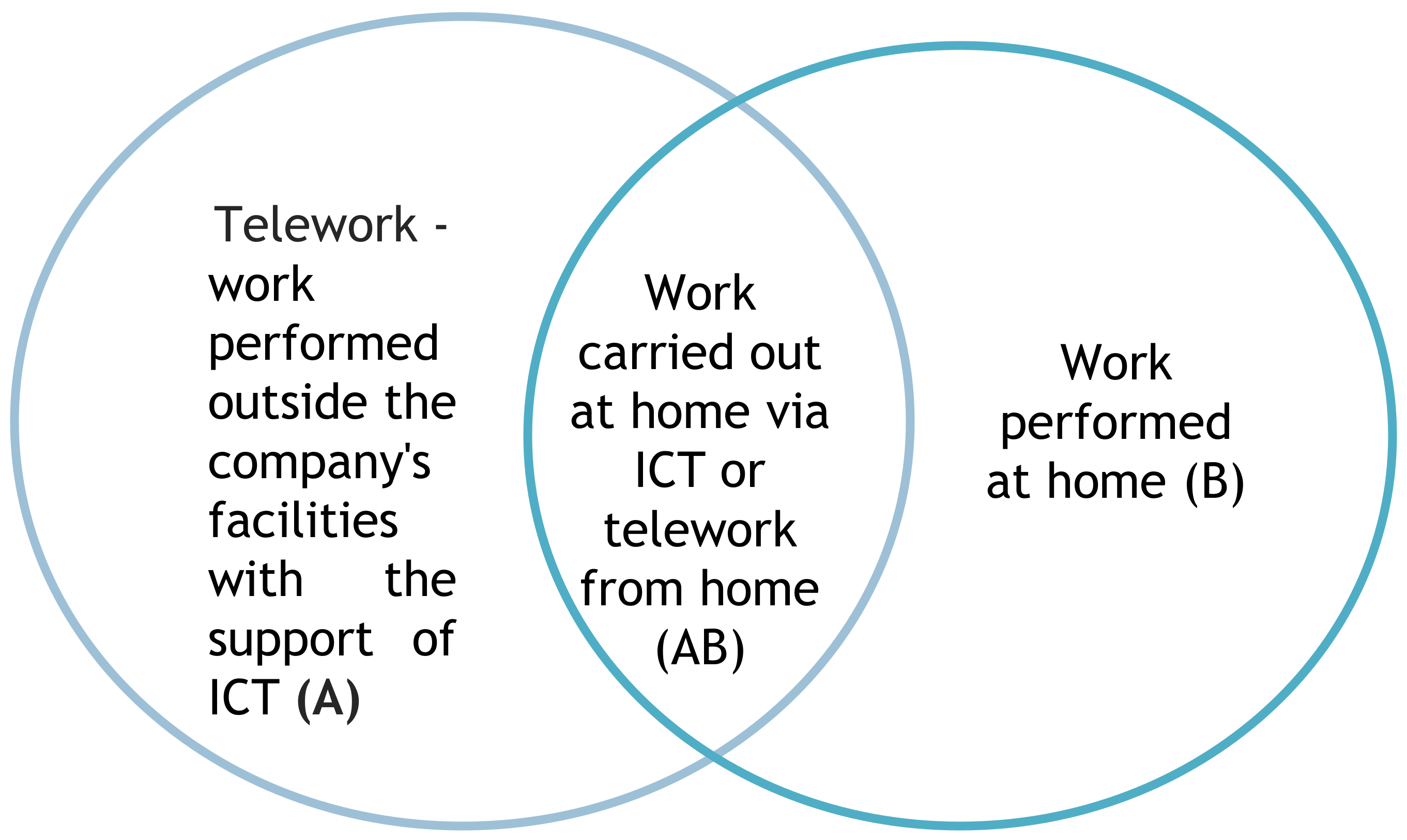
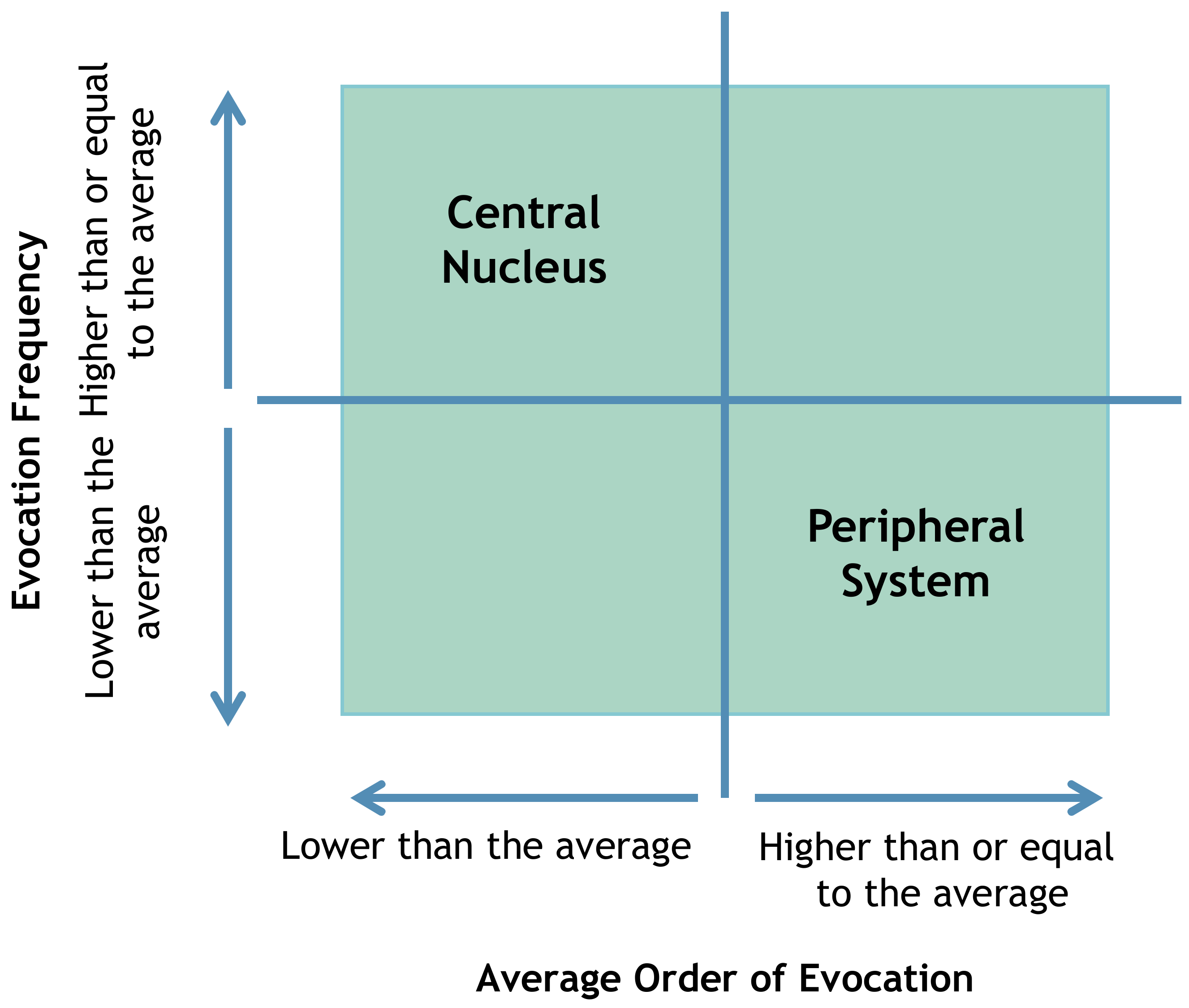
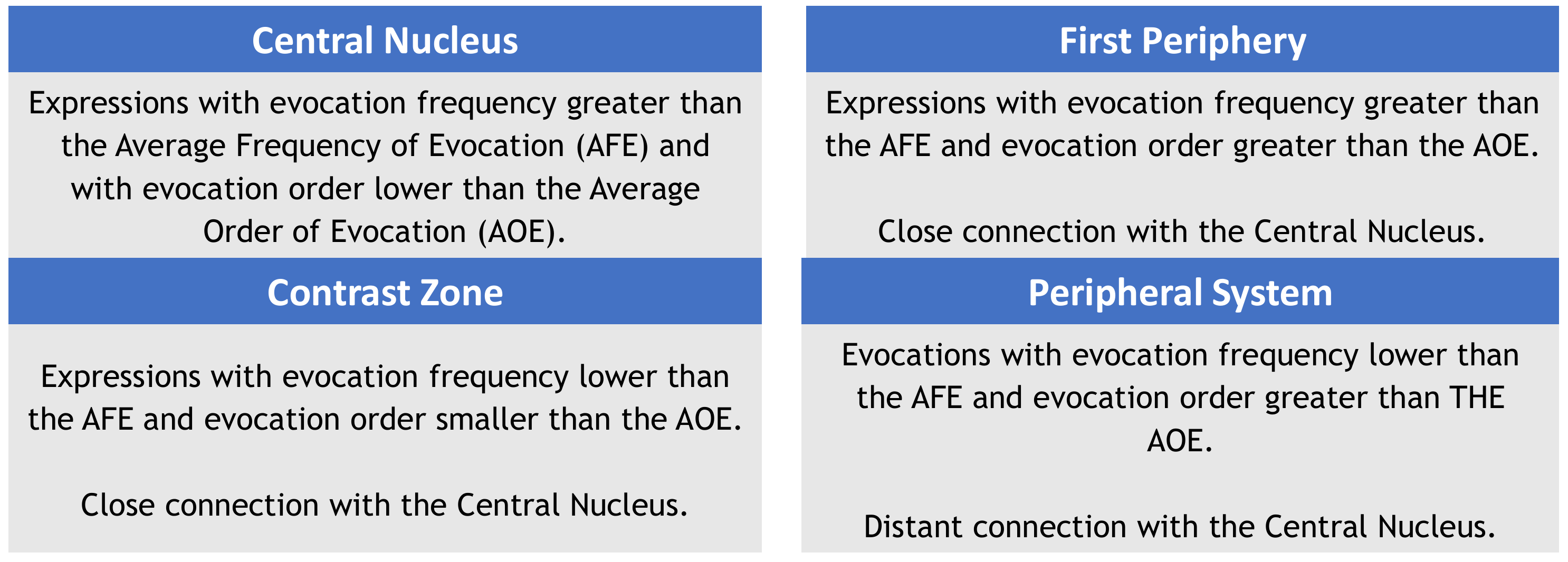
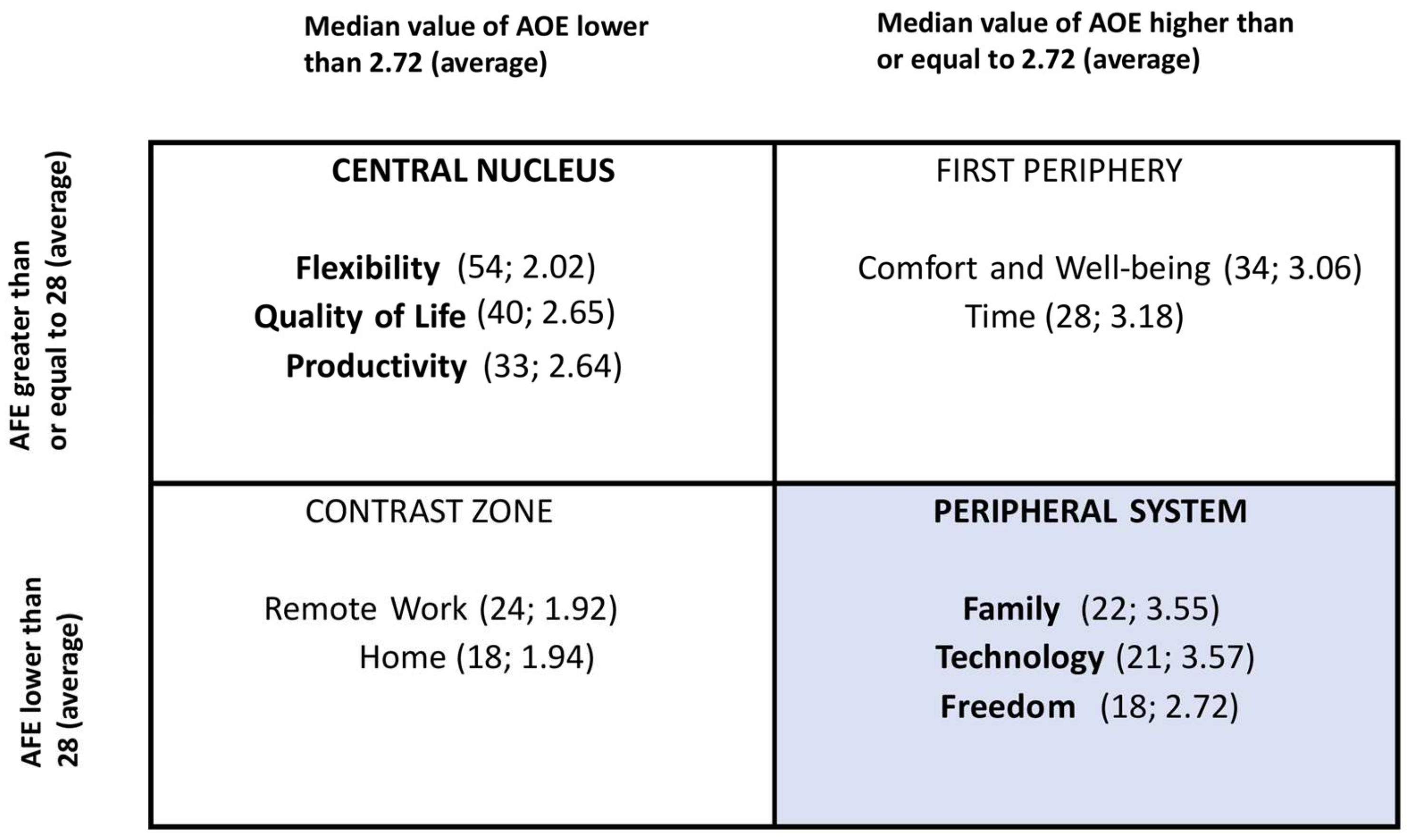
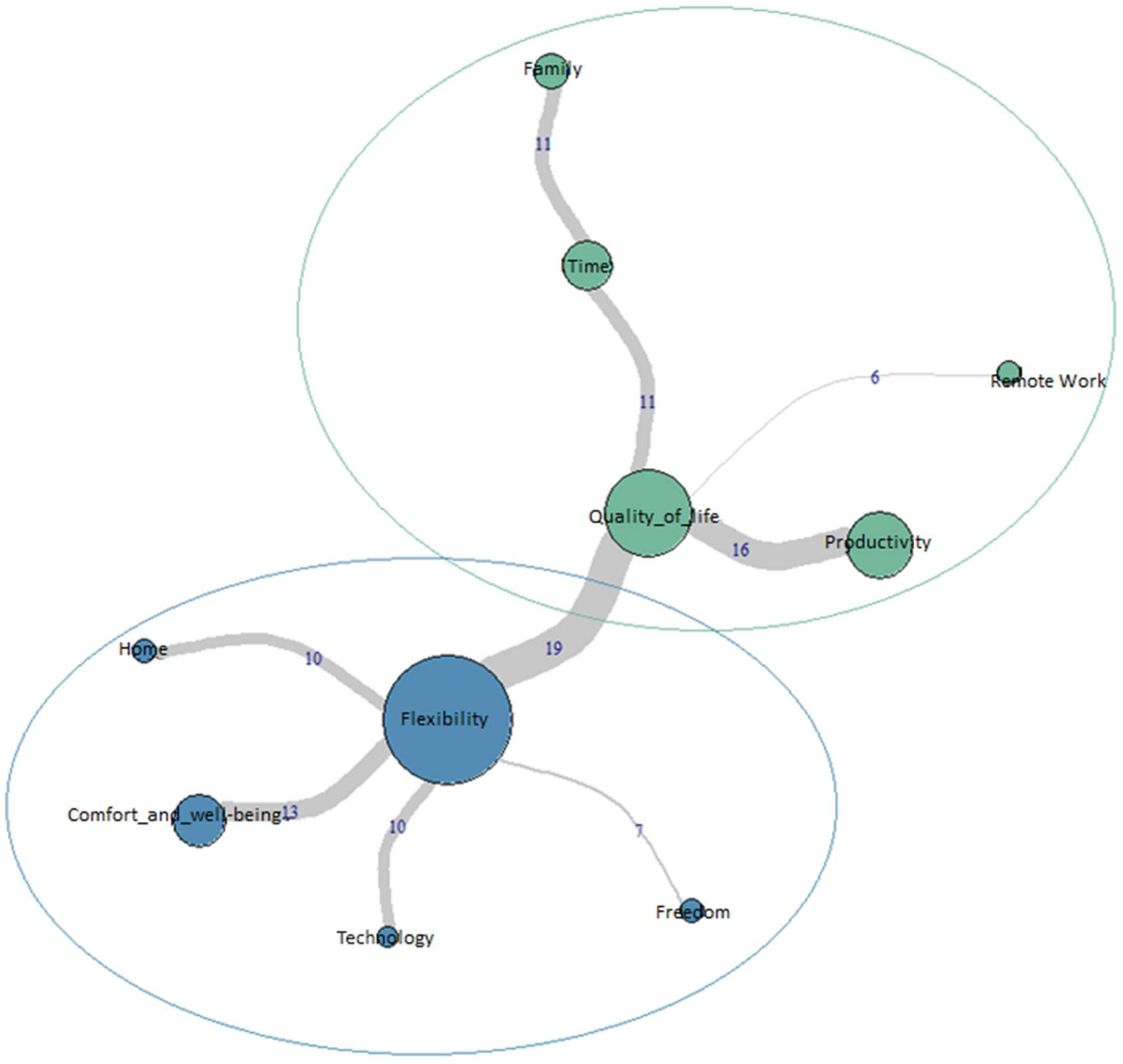
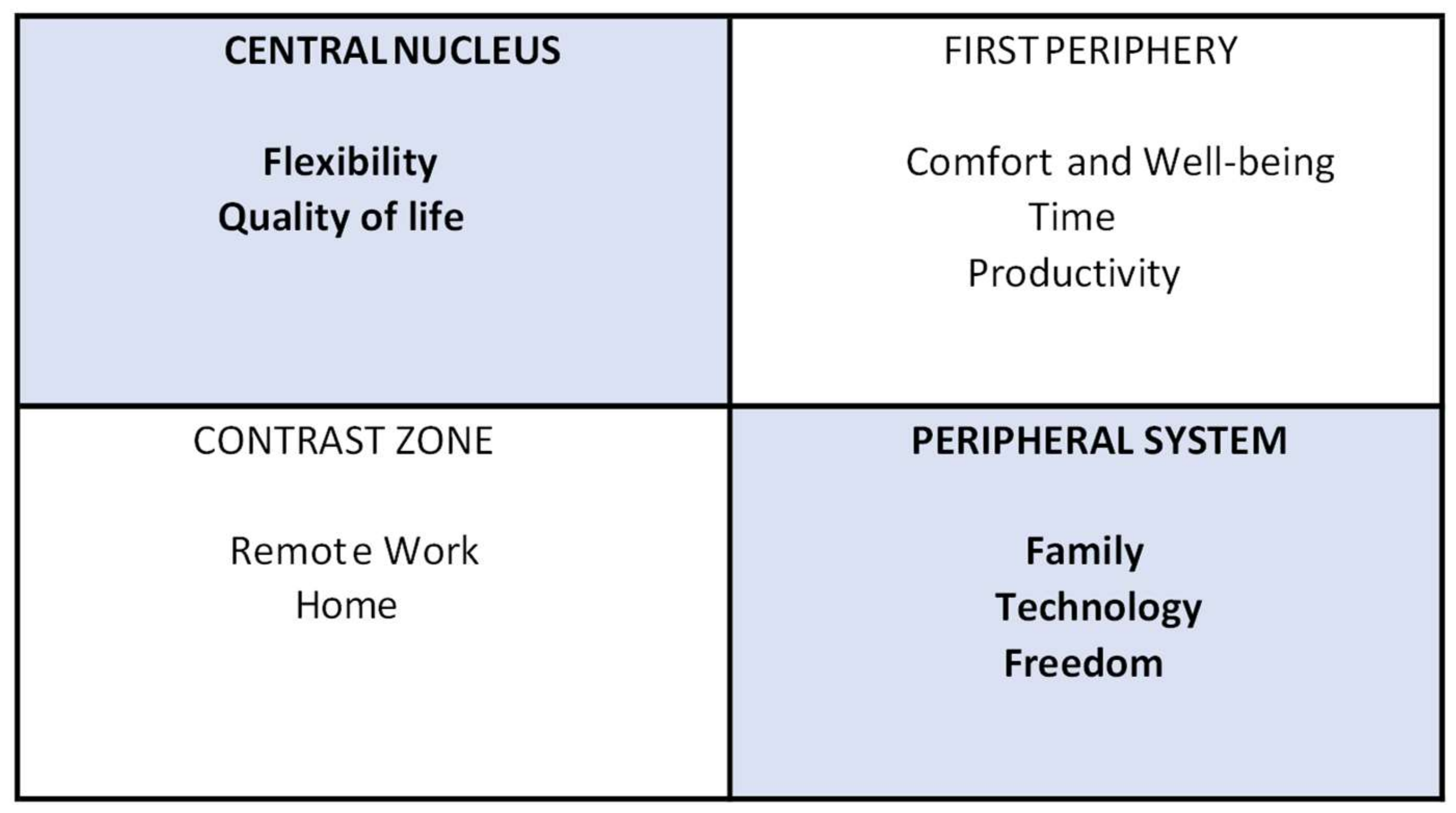
| Types of Telework | Characteristics |
|---|---|
| Based at home | Work from home but not necessarily every day |
| Connection with the central office through ICT | |
| Link with the company | |
| Company or employee provide furniture and equipment | |
| Avoid hours of daily commuting | |
| Satellite offices | Work away from home and central office |
| Host only employees from the same company | |
| Avoid hours of daily commuting | |
| Company provides furniture and equipment | |
| Backoffice may be available | |
| Neighbourhood working centers | Work away from home and central office |
| Host employees from several companies | |
| Avoid hours of daily commuting | |
| Owners or companies provide furniture and equipment | |
| Mobile work | Usually on the road |
| Use of ICT | |
| Work from home, auto, airplane, or hotel |
| Home-Office Features | Theoretical References | ||||||||||||
|---|---|---|---|---|---|---|---|---|---|---|---|---|---|
| [24] | [22] | [25] | [45] | [26] | [46] | [13,21] | [47] | [48,49] | [50] | [51] | [52] | [53] | |
| Cost reduction | ₀ | ₀ | ₀ | ₀ | ₀ | ₀ | ₀ | ₀ | ₀ | ₀ | ₀ | ||
| Autonomy/Flexibility | ₀ | ₀ | ₀ | ₀ | ₀ | ₀ | ₀ | ₀ | ₀ | ₀ | |||
| Equilibrium family/work | ₀ | ₀ | ₀ | ₀ | ₀ | ₀ | ₀ | ₀ | ₀ | ₀ | |||
| Productivity | ₀ | ₀ | ₀ | ₀ | ₀ | ₀ | ₀ | ₀ | ₀ | ₀ | |||
| Leadership role | ₀ | ₀ | ₀ | ₀ | ₀ | ₀ | ₀ | ₀ | ₀ | ||||
| Personal and professional isolation | ₀ | ₀ | ₀ | ₀ | ₀ | ₀ | ₀ | ₀ | ₀ | ||||
| Interaction/Communication | ₀ | ₀ | ₀ | ₀ | ₀ | ₀ | ₀ | ₀ | ₀ | ||||
| Impacts on the organizational culture/motivation/commitment | ₀ | ₀ | ₀ | ₀ | ₀ | ₀ | ₀ | ₀ | ₀ | ||||
| Visibility/development/career opportunities | ₀ | ₀ | ₀ | ₀ | ₀ | ₀ | ₀ | ₀ | |||||
| Infrastructure and technology | ₀ | ₀ | ₀ | ₀ | ₀ | ₀ | ₀ | ₀ | |||||
| Commute time | ₀ | ₀ | ₀ | ₀ | ₀ | ₀ | ₀ | ₀ | |||||
| Accessibility | ₀ | ₀ | ₀ | ₀ | ₀ | ₀ | |||||||
| Well-being of the worker | ₀ | ₀ | ₀ | ₀ | ₀ | ₀ | |||||||
| Job satisfaction and performance | ₀ | ₀ | ₀ | ₀ | ₀ | ₀ | |||||||
| Level of distraction/interaction | ₀ | ₀ | ₀ | ₀ | ₀ | ||||||||
| Working hours | ₀ | ₀ | ₀ | ₀ | ₀ | ||||||||
| Physical environment | ₀ | ₀ | ₀ | ₀ | |||||||||
| Greater stress/exhaustion | ₀ | ₀ | ₀ | ₀ | |||||||||
| Professional identity | ₀ | ₀ | ₀ | ||||||||||
| Safety | ₀ | ₀ | |||||||||||
| Knowledge sharing | ₀ | ₀ | |||||||||||
| Central Nucleus Features | Peripheral System Features |
|---|---|
| Linked to the collective memory and the history of the group | Enables the integration of individual experiences and stories |
| Consensual: defines the homogeneity of the group | Supports group heterogeneity |
| Stable, coherent, and rigid | Flexible and supports contradictons |
| Resistant to change | Transformable |
| Little sensitivity to the immediate context | Sensitive to the immediate context |
| Generates the meaning of the representation and | Allows adaptation to the reality and the differentiation of the content; protects the |
| determines its organization | central nucleus |
| Sample Summary |
|---|
| 148 participants |
| 106 valid answers |
| 530 words/expressions evoked |
| 9 differente states—93.4% from Rio de Janeiro and São Paulo states |
| Average age—41 years old |
| 70% Female and 30% Male |
| 89% with Post-Graduation, Master or Doctoral degree |
| 94% involved with Home-Office Implementation Initiatives |
| Frequency of Evocation | No. of Categories | Accumulated Evocations (%) | Reverse Accumulation (%) |
|---|---|---|---|
| 1 | 14 | 2.64 | 100.00 |
| 2 | 3 | 3.77 | 97.36 |
| 3 | 9 | 8.85 | 96.23 |
| 4 | 6 | 13.37 | 91.15 |
| 5 | 2 | 15.25 | 86.63 |
| 6 | 4 | 19.77 | 84.75 |
| 7 | 1 | 21.09 | 80.23 |
| 8 | 2 | 24.11 | 78.91 |
| 10 | 3 | 29.76 | 75.89 |
| 11 | 3 | 35.97 | 70.24 |
| 14 | 1 | 38.61 | 64.03 |
| 15 | 1 | 41.43 | 61.39 |
| 17 | 1 | 44.63 | 58.57 |
| 18 | 2 | 51.41 | 55.37 |
| 21 | 1 | 55.37 | 48.59 |
| 22 | 1 | 59.51 | 44.63 |
| 27 | 1 | 64.60 | 40.49 |
| 28 | 1 | 69.87 | 35.40 |
| 33 | 1 | 76.08 | 30.13 |
| 34 | 1 | 82.49 | 23.92 |
| 40 | 1 | 90.02 | 17.51 |
| 53 | 1 | 100.00 | 9.98 |
| Subcategories | Freq | 1st. | 2nd. | 3rd. | 4th. | 5th. | AOE |
|---|---|---|---|---|---|---|---|
| Flexibility | 50 | 25 | 14 | 6 | 7 | 2 | 2.02 |
| Quality of life | 40 | 10 | 11 | 8 | 5 | 6 | 2.65 |
| Comfort and Well-being | 34 | 9 | 3 | 7 | 7 | 8 | 3.06 |
| Productivity | 33 | 9 | 10 | 4 | 4 | 6 | 2.64 |
| Time | 28 | 4 | 2 | 10 | 9 | 3 | 3.18 |
| Remote work | 24 | 14 | 4 | 2 | 2 | 2 | 1.92 |
| Family | 22 | 1 | 5 | 4 | 5 | 7 | 3.55 |
| Technology | 21 | 0 | 3 | 7 | 7 | 4 | 3.57 |
| Home | 18 | 7 | 8 | 1 | 1 | 1 | 1.94 |
| Freedom | 18 | 3 | 4 | 7 | 3 | 1 | 2.72 |
| Parameter | Value |
|---|---|
| Minimum frequency of evocation | 18 |
| Average frequency of evocation | 28 |
| Median value of AOE | 2.72 |
| Categories | Edges | Co-Occurences | Avg. [Co-Occurrences/Edges] | Frequencies | AOE |
|---|---|---|---|---|---|
| Flexibility | 5 | 59 | 11.8 | 54 | 2.02 |
| Quality of life | 4 | 52 | 13.0 | 40 | 2.65 |
| Comfort and Well-being | 1 | 13 | 13.0 | 34 | 3.06 |
| Productivity | 1 | 16 | 16.0 | 33 | 2.64 |
| Time | 2 | 22 | 11.0 | 28 | 3.18 |
| Remote work | 1 | 6 | 6.0 | 24 | 1.92 |
| Family | 1 | 11 | 11.0 | 22 | 3.55 |
| Technology | 1 | 10 | 10.0 | 21 | 3.57 |
| Home | 1 | 10 | 10.0 | 18 | 1.94 |
| Freedom | 1 | 7 | 7.0 | 18 | 2.72 |
| Category Associated with Home-Office | Theoretical References | Occurrence of the Category in the Analysis |
|---|---|---|
| Flexibility | Madsen [24]; Bailey & Kurland [22]; Wheatley [45]; Nakrošienė et al. [46]; Boell et al. [13,21]; Lippe & Lippényi [47]; Tietze [48,49]; Pérez et al. [50]; Harris [51]; Meroño-Cerdán [52] | Central Nucleus; SA |
| Quality of life | Madsen [24]; Bailey & Kurland [22]; Overmyer [25]; Wheatley [45]; Mahler [26]; Nakrošienė et al. [46]; Boell et al. [13,21]; Lippe & Lippényi [47]; Tietze [48,49]; Pérez et al. [50]; Harris [51]; Meroño-Cerdán [52]; Malik et al. [53] | Central Nucleus; SA |
| Family | Madsen [24]; Bailey & Kurland [22]; Wheatley [45]; Mahler [26]; Nakrošienė et al. [46]; Boell et al. [13,21]; Lippe & Lippényi [47]; Tietze [48,49]; Harris [51]; Malik et al. [53] | Peripheral System; SA |
| Technology | Bailey & Kurland [22]; Overmyer [25]; Mahler [26]; Nakrošienė et al. [46]; Boell et al. [21]; Pérez et al. [50]; Harris [51]; Meroño-Cerdán [52] | Peripheral System; SA |
| Freedom | Bailey & Kurland [22]; Nakrošienė et al. [46]; Boell et al. [13,21]; Harris [51]; Malik et al. [53]; Pyöriä [18] | Peripheral System; SA |
| Productivity | Madsen [24]; Bailey & Kurland [22]; Wheatley [45]; Mahler [26]; Nakrošienė et al. [46]; Boell et al. [13,21]; Lippe & Lippényi [47]; Tietze [48,49]; Pérez et al. [50]; Harris [51]; Meroño-Cerdán [52]; Malik et al. [53] | First Periphery; SA |
Disclaimer/Publisher’s Note: The statements, opinions and data contained in all publications are solely those of the individual author(s) and contributor(s) and not of MDPI and/or the editor(s). MDPI and/or the editor(s) disclaim responsibility for any injury to people or property resulting from any ideas, methods, instructions or products referred to in the content. |
© 2023 by the authors. Licensee MDPI, Basel, Switzerland. This article is an open access article distributed under the terms and conditions of the Creative Commons Attribution (CC BY) license (https://creativecommons.org/licenses/by/4.0/).
Share and Cite
Joia, L.A.; Leonardo, L.F. The COVID-19 Pandemic and the Digital Transformation of Workplace: The Social Representation of Home-Office. Sustainability 2023, 15, 14987. https://doi.org/10.3390/su152014987
Joia LA, Leonardo LF. The COVID-19 Pandemic and the Digital Transformation of Workplace: The Social Representation of Home-Office. Sustainability. 2023; 15(20):14987. https://doi.org/10.3390/su152014987
Chicago/Turabian StyleJoia, Luiz Antonio, and Lineu Fachin Leonardo. 2023. "The COVID-19 Pandemic and the Digital Transformation of Workplace: The Social Representation of Home-Office" Sustainability 15, no. 20: 14987. https://doi.org/10.3390/su152014987
APA StyleJoia, L. A., & Leonardo, L. F. (2023). The COVID-19 Pandemic and the Digital Transformation of Workplace: The Social Representation of Home-Office. Sustainability, 15(20), 14987. https://doi.org/10.3390/su152014987




